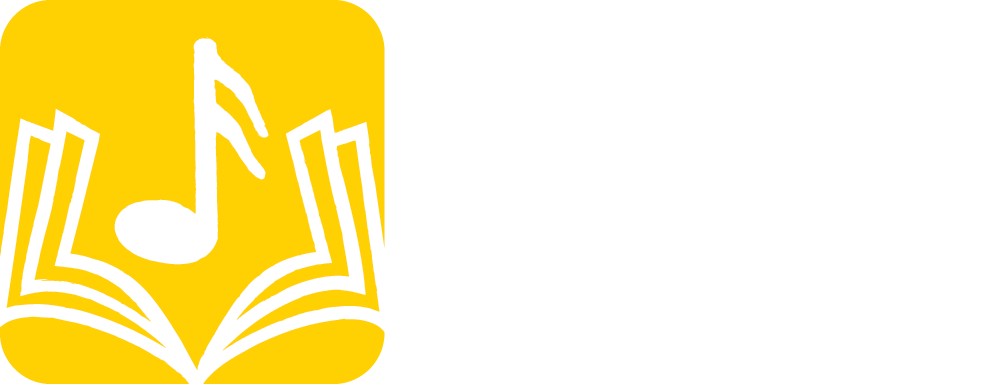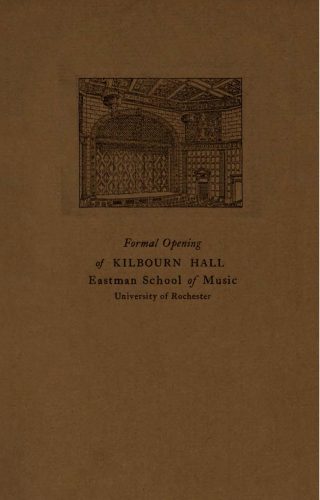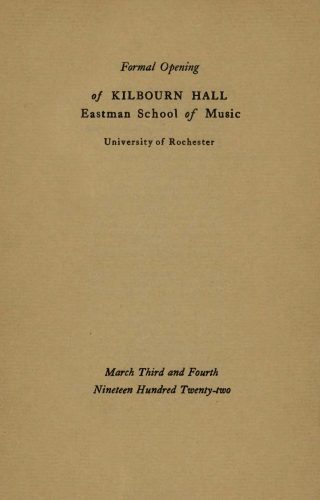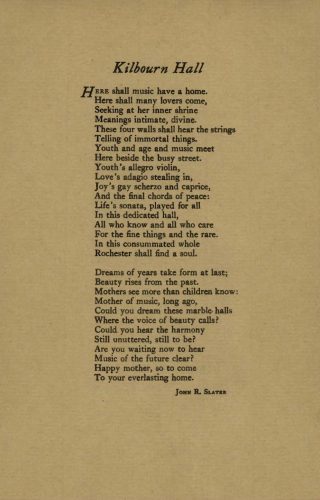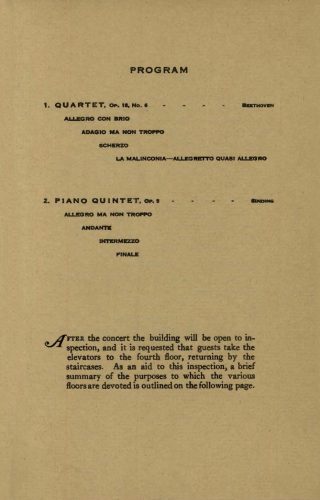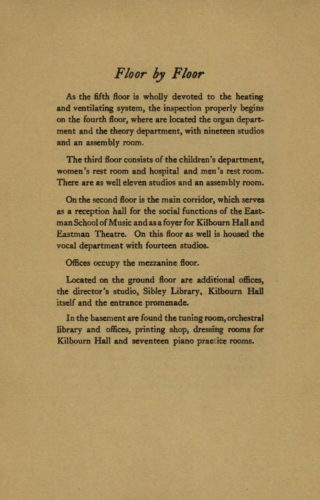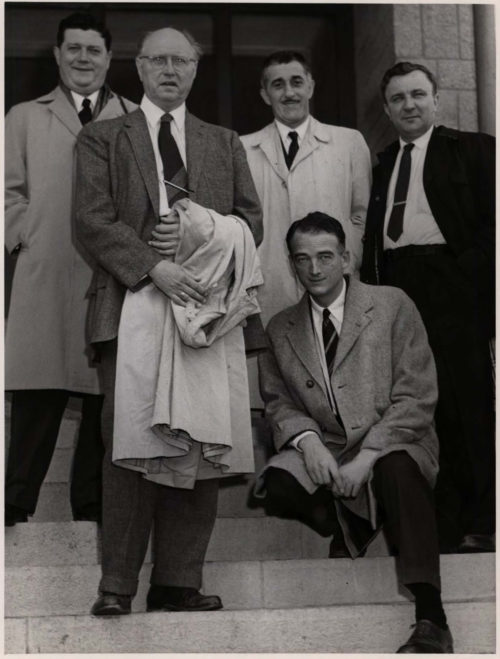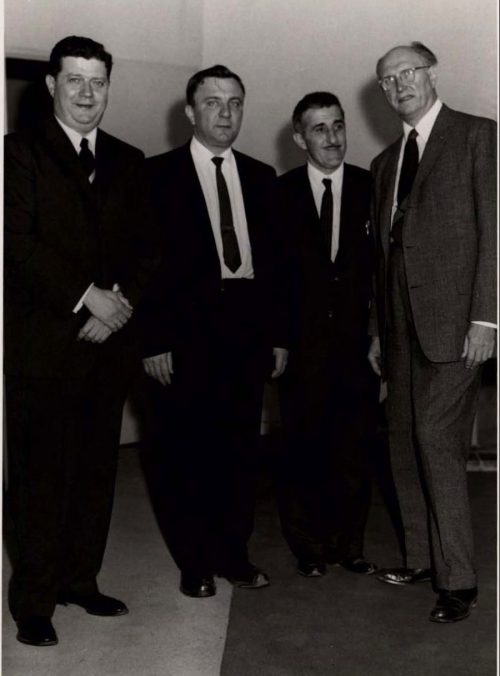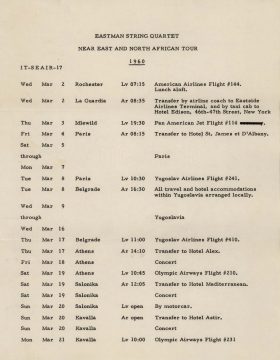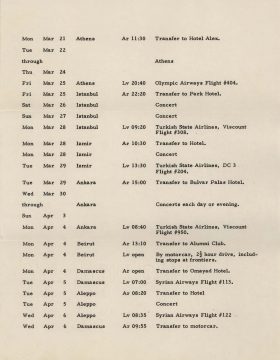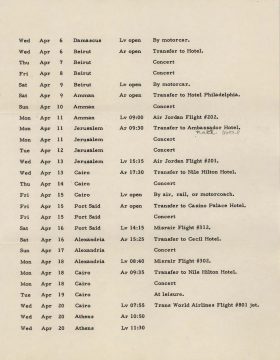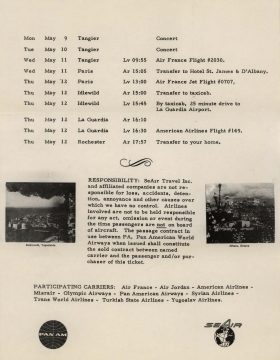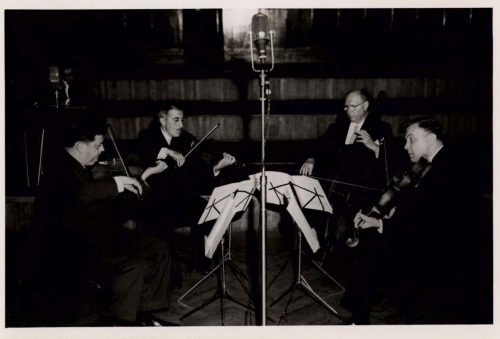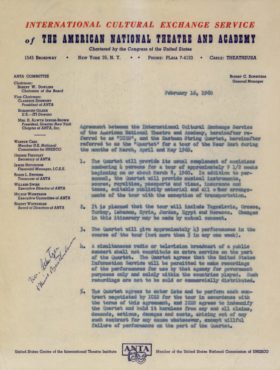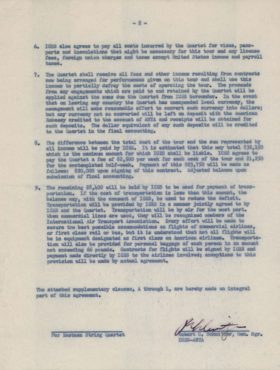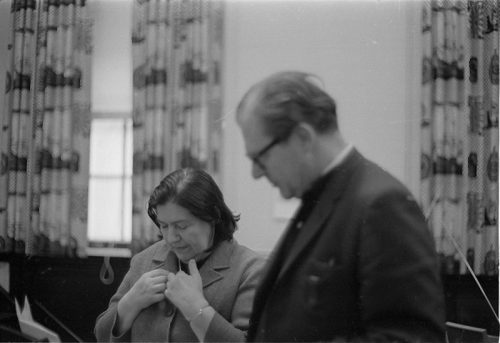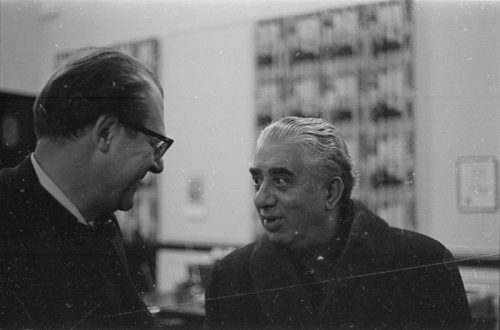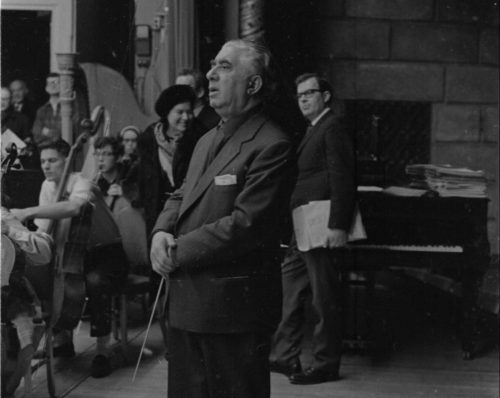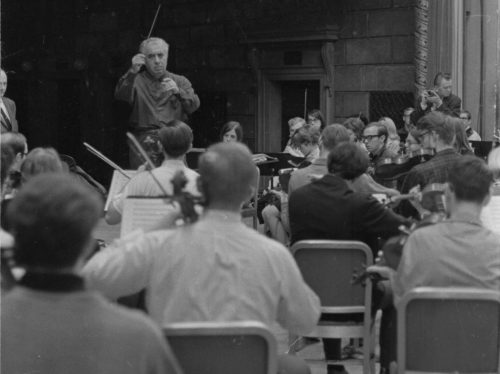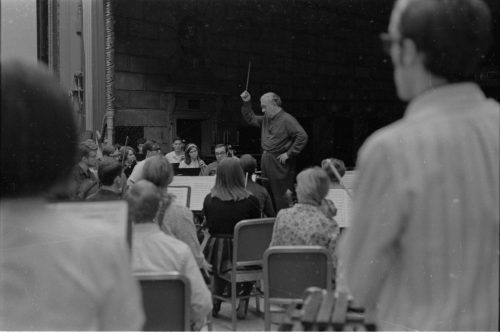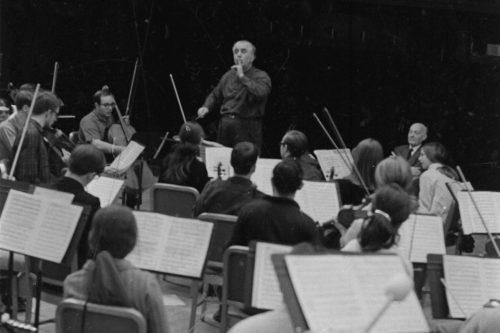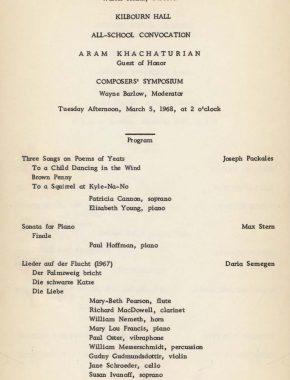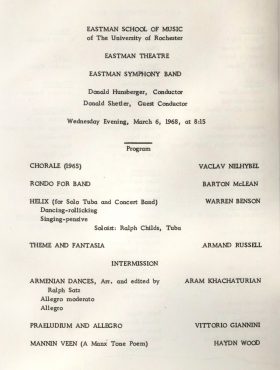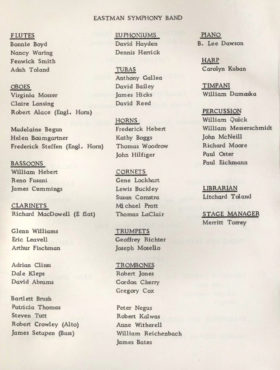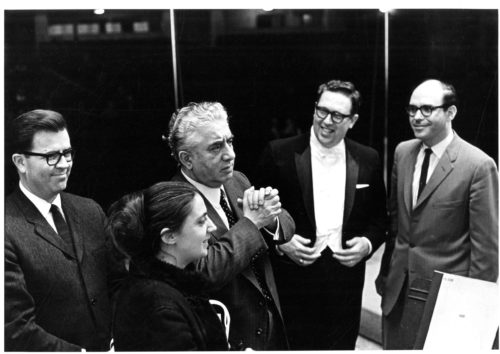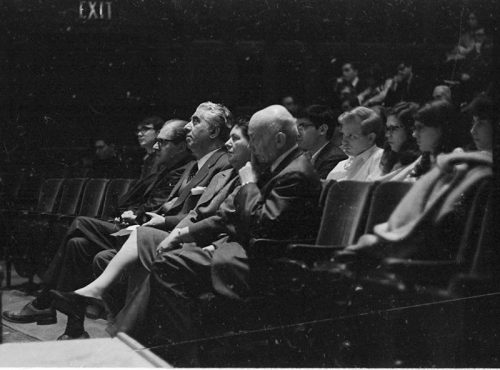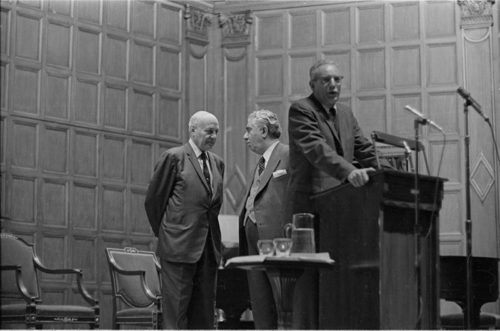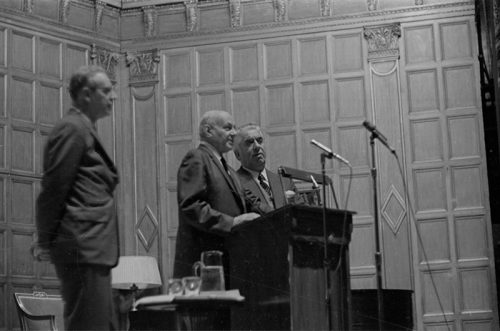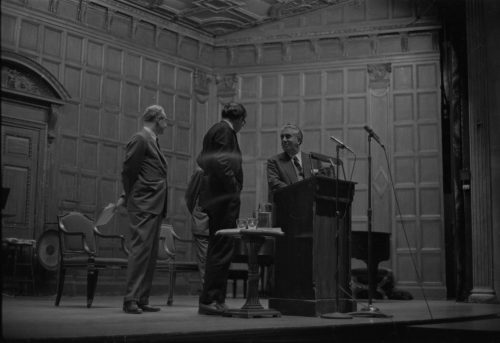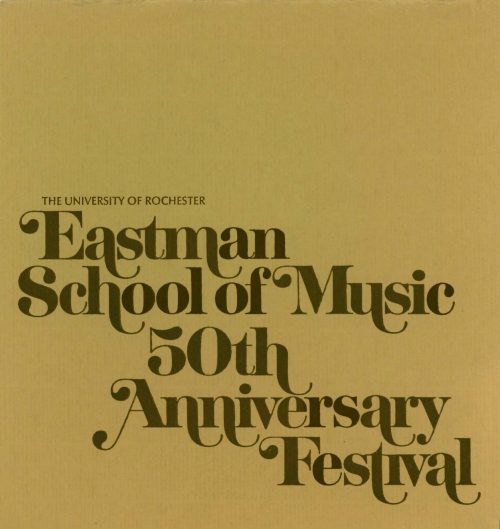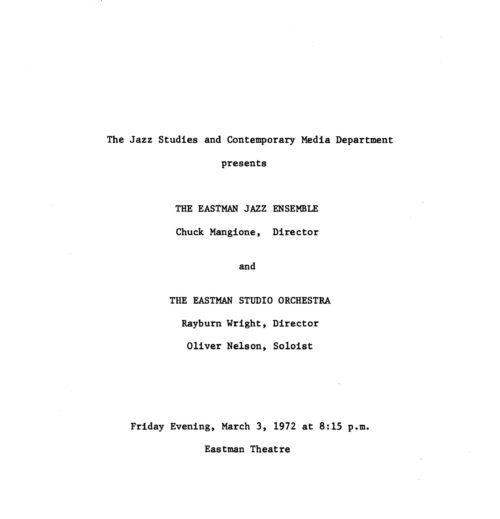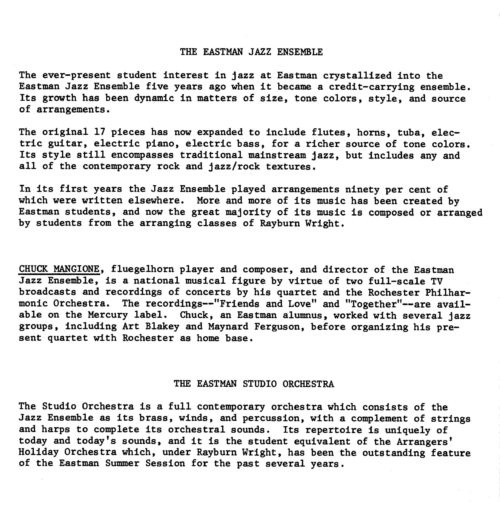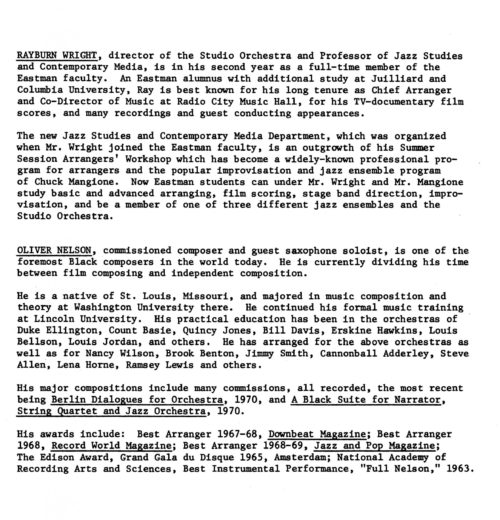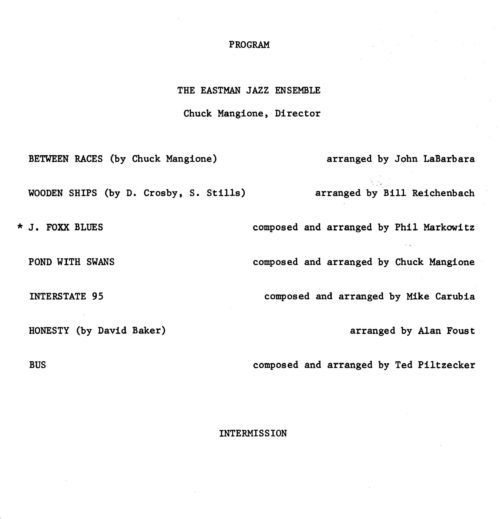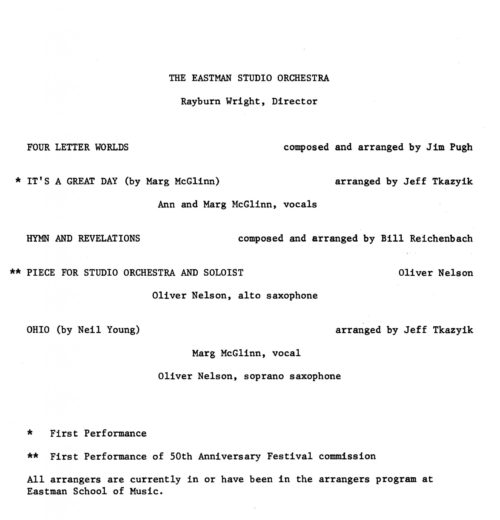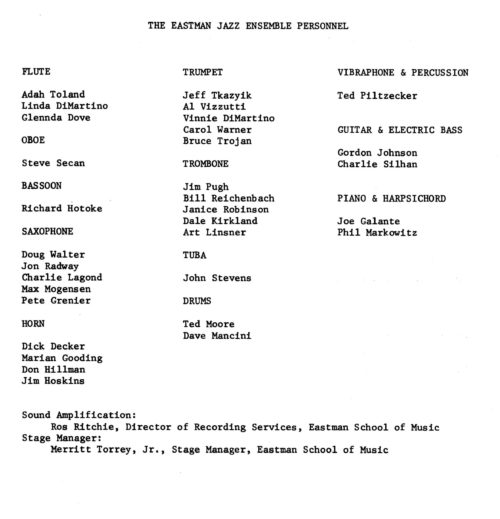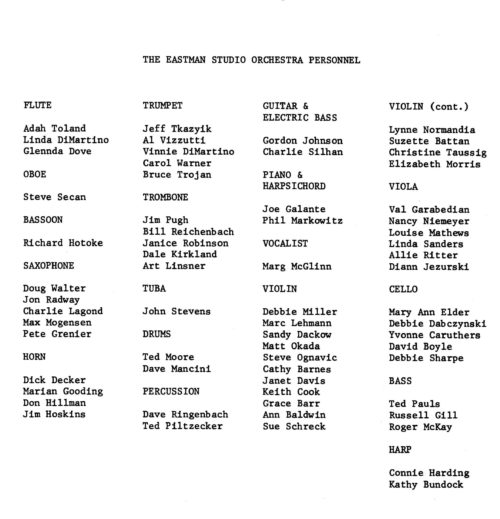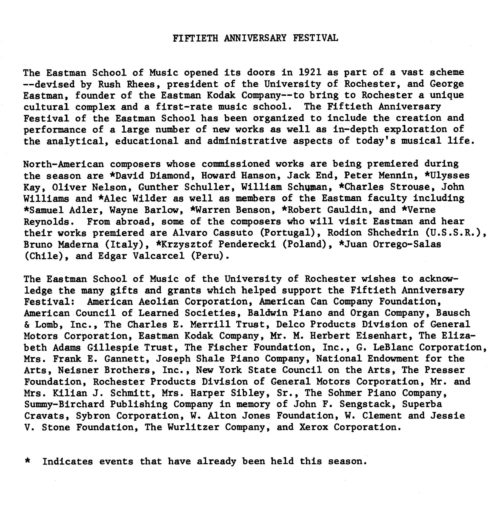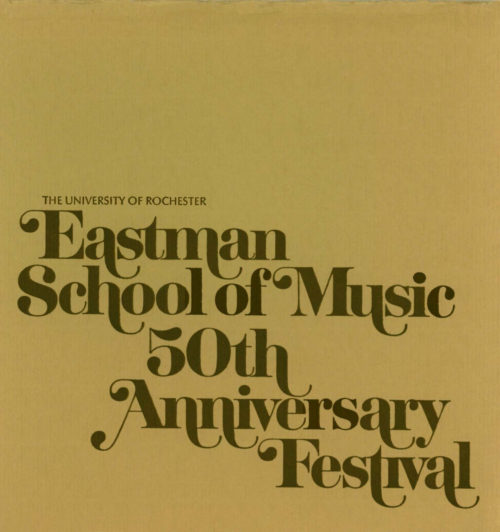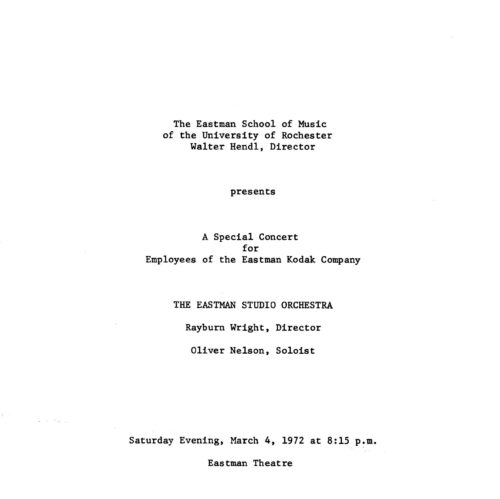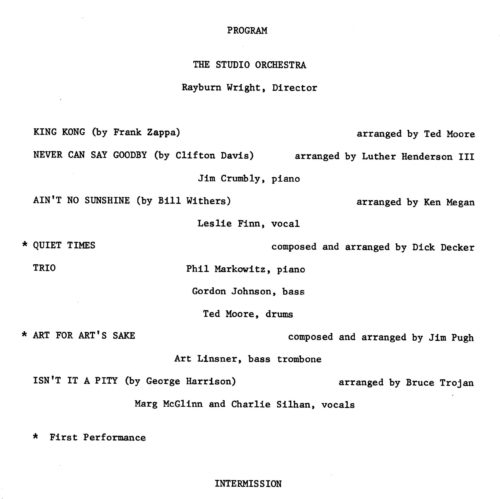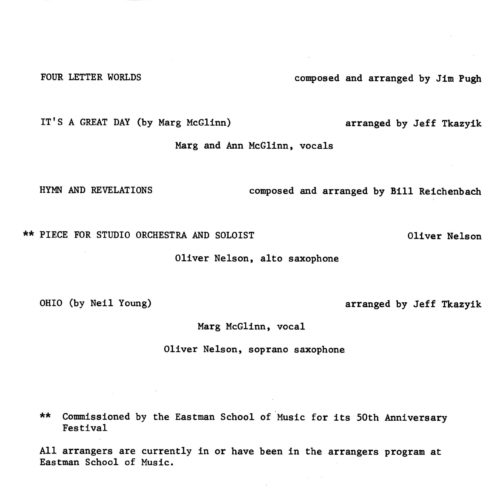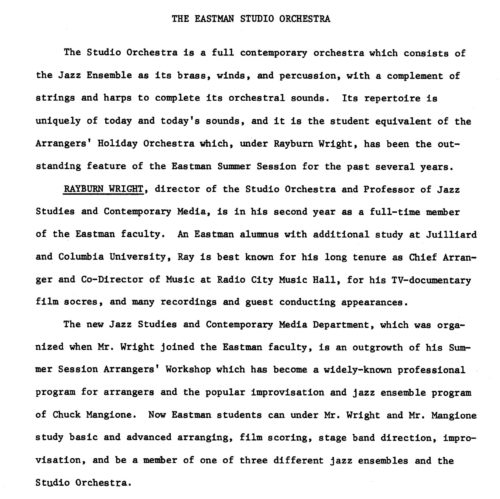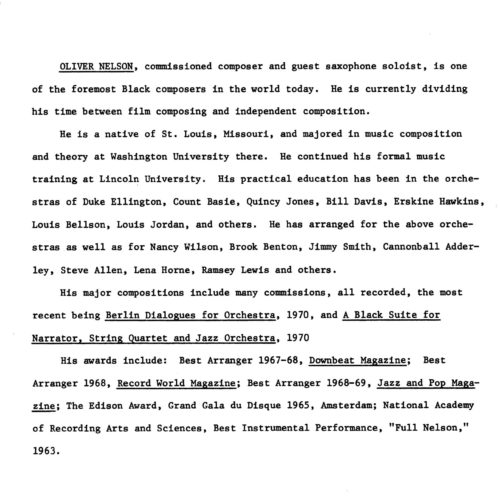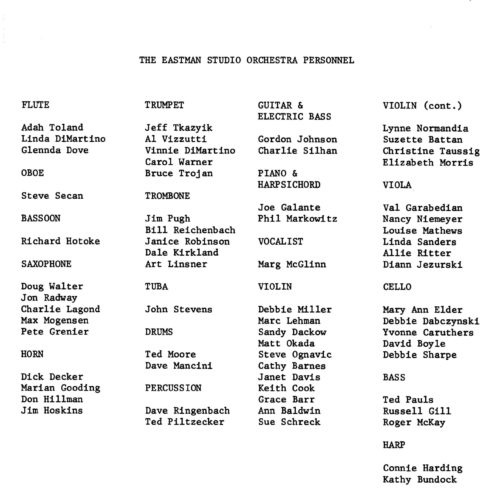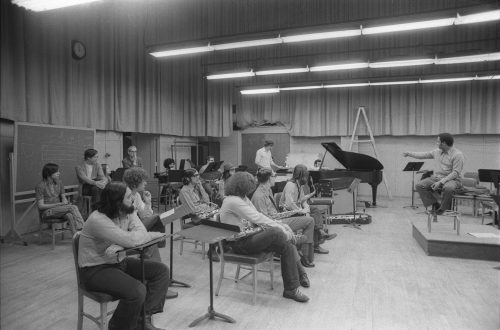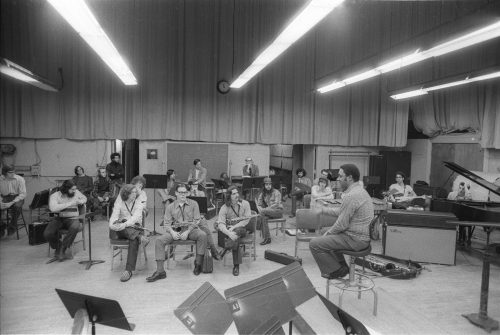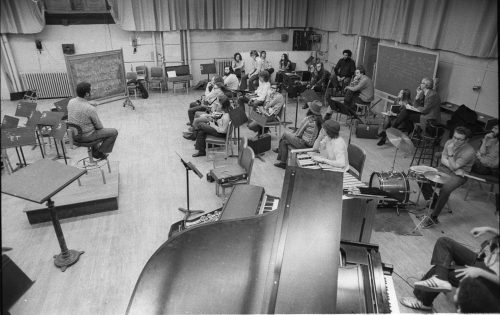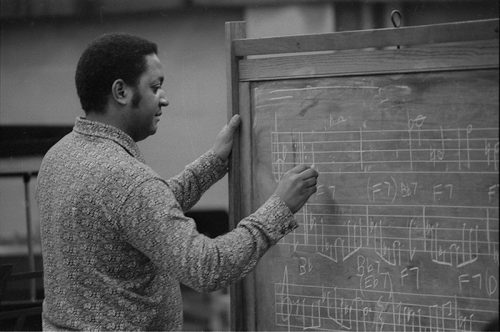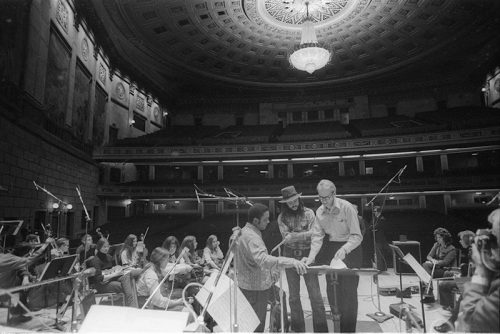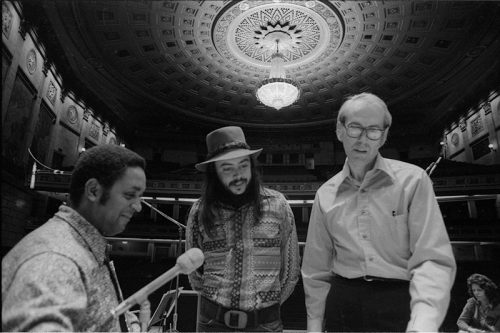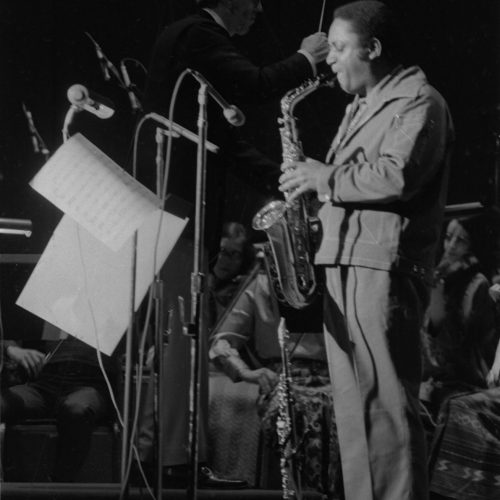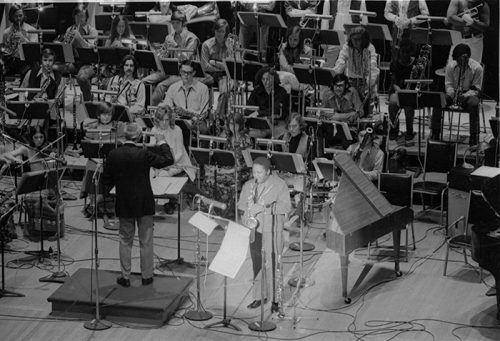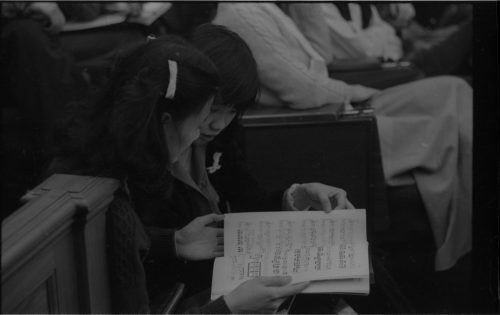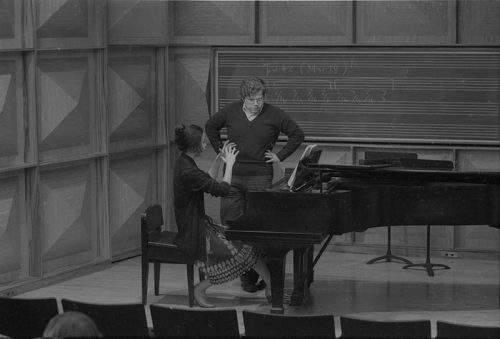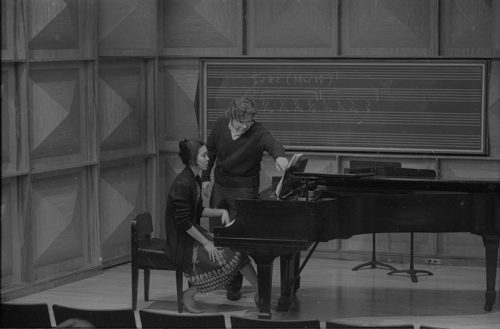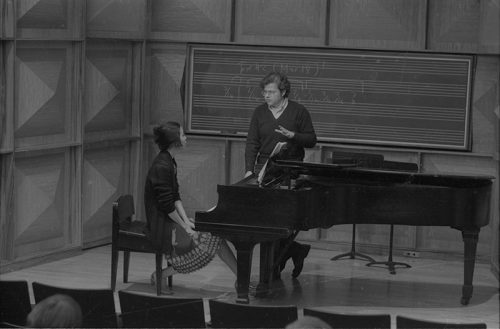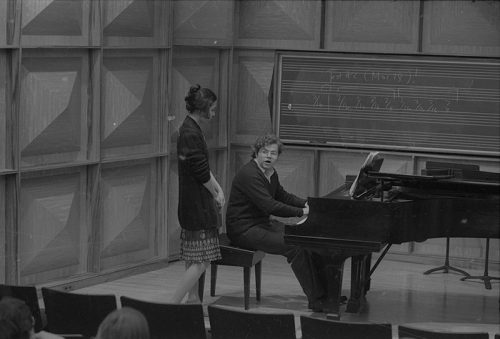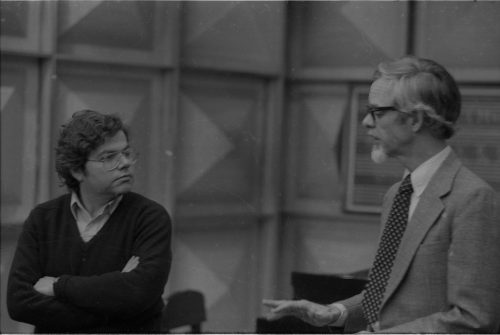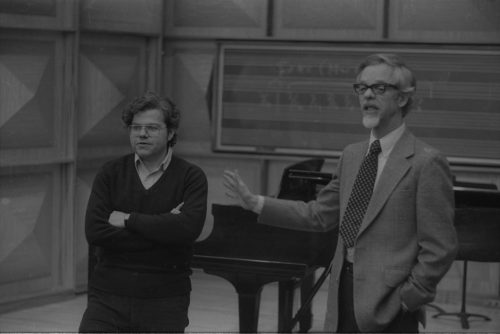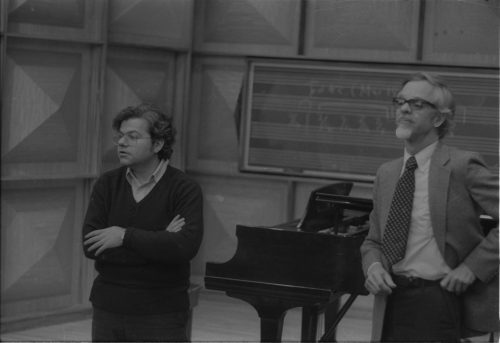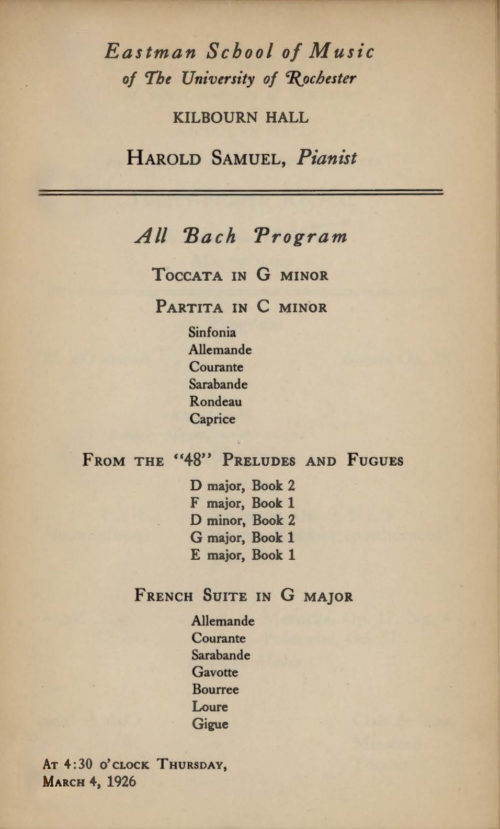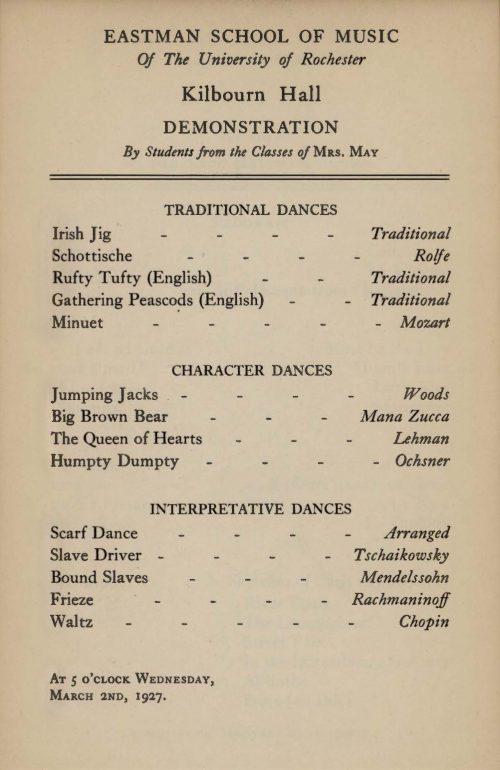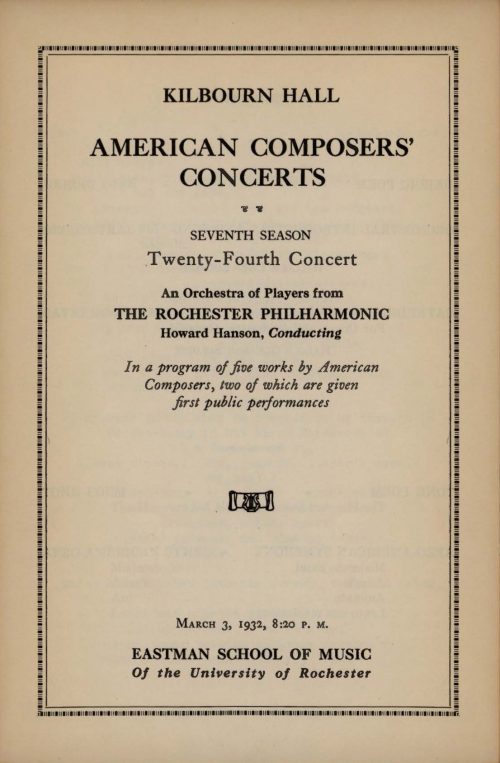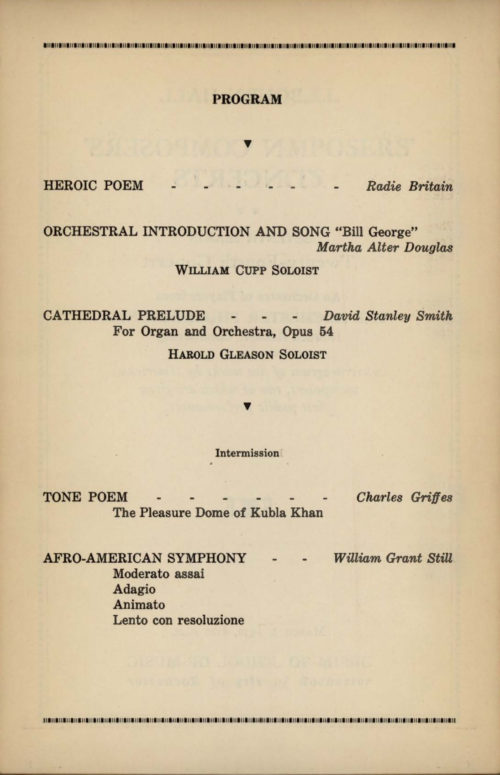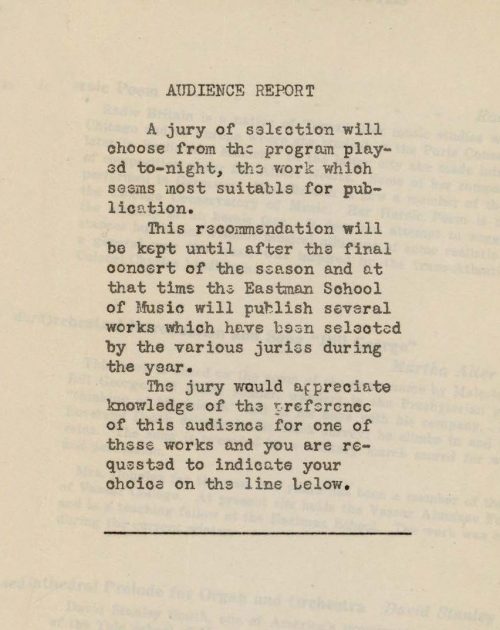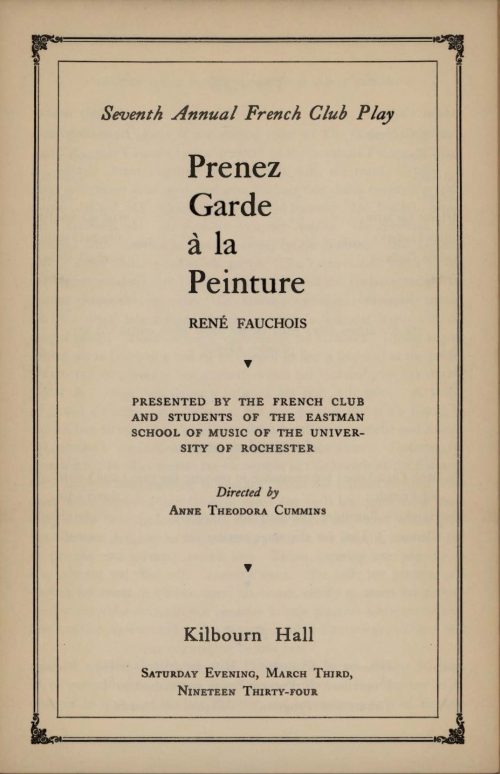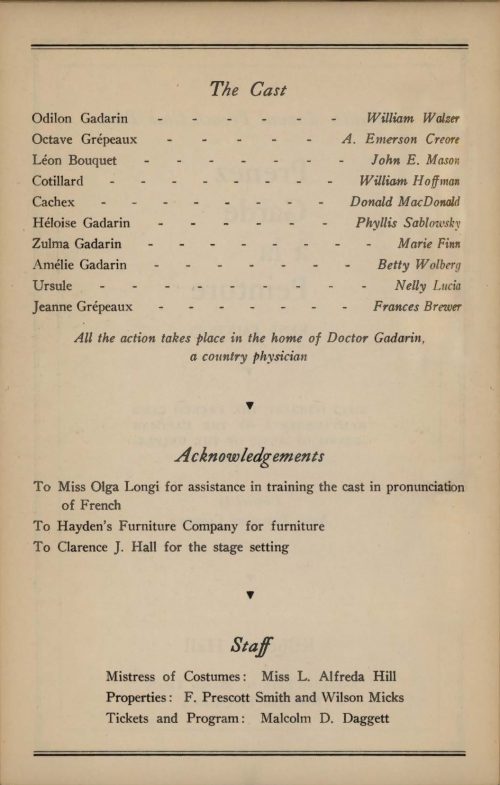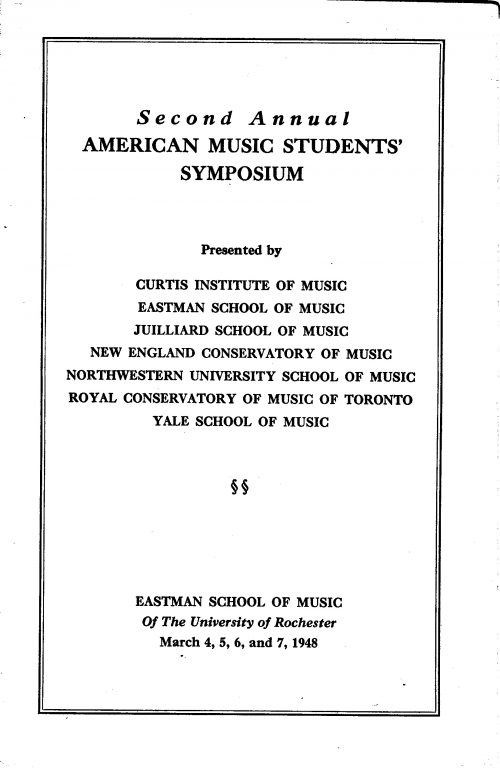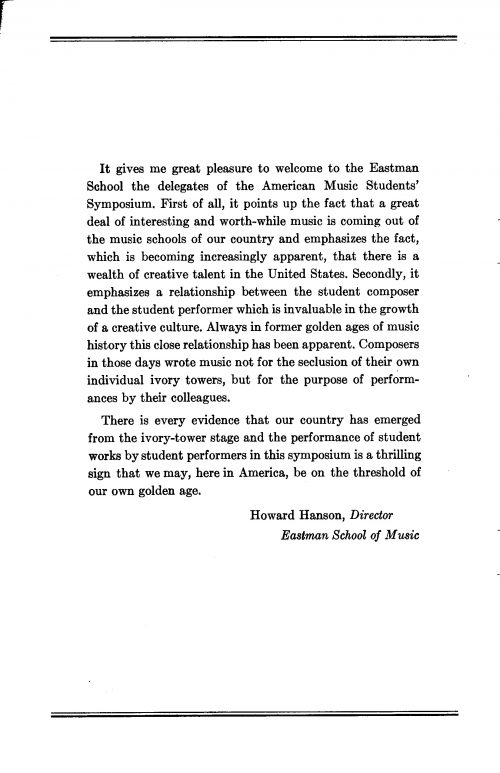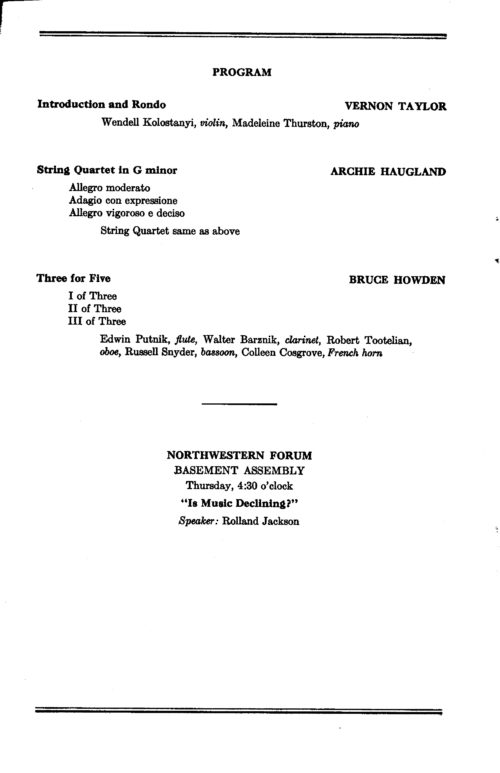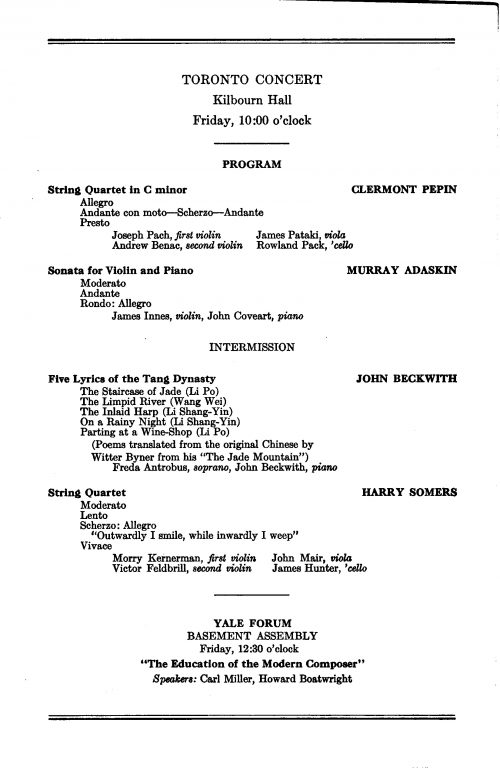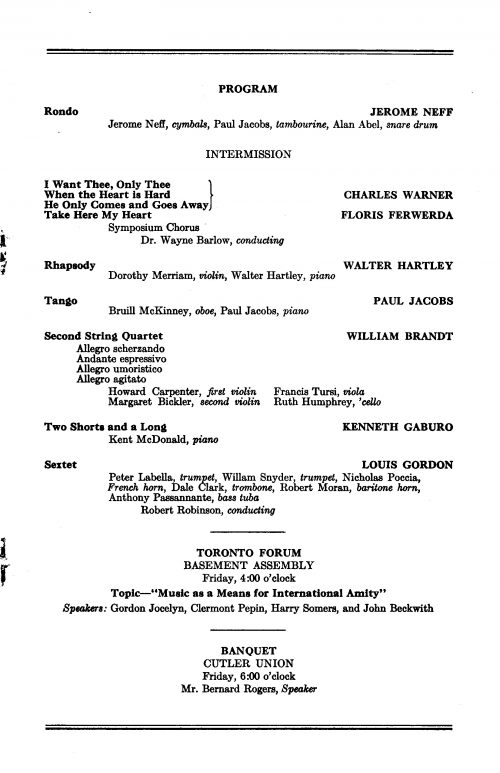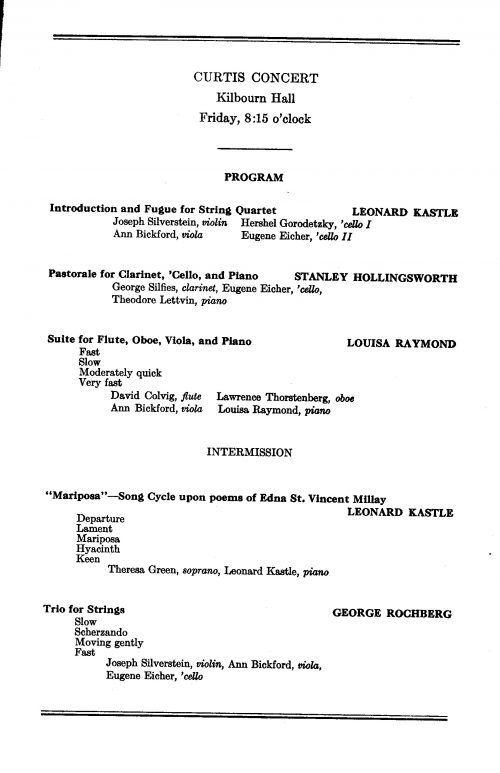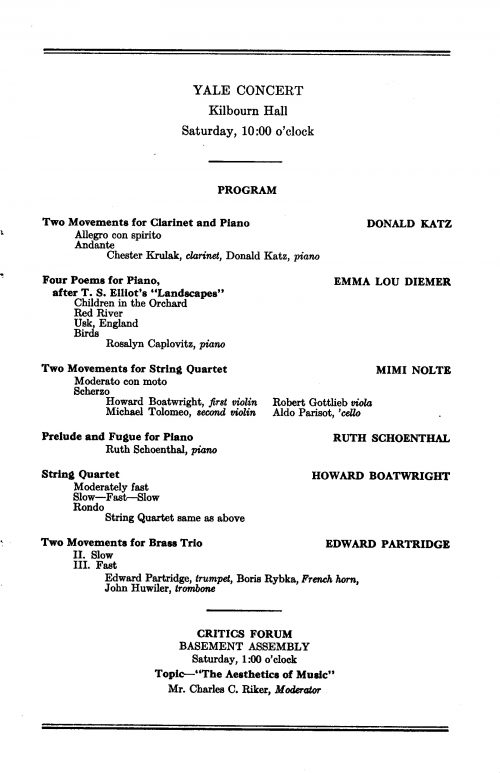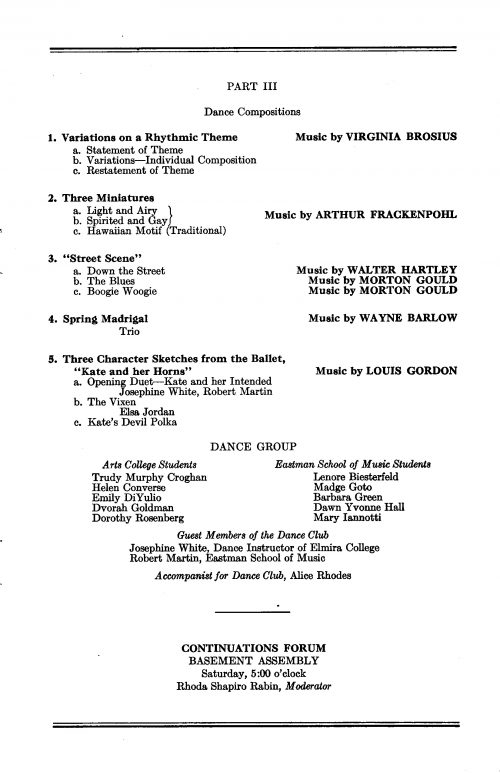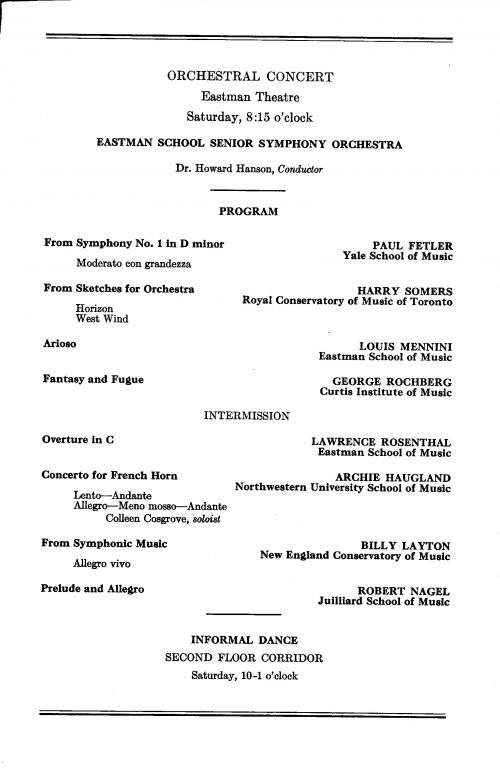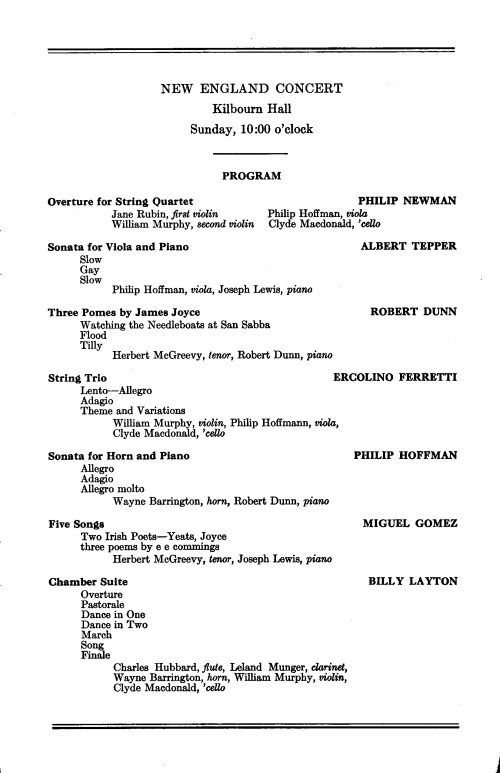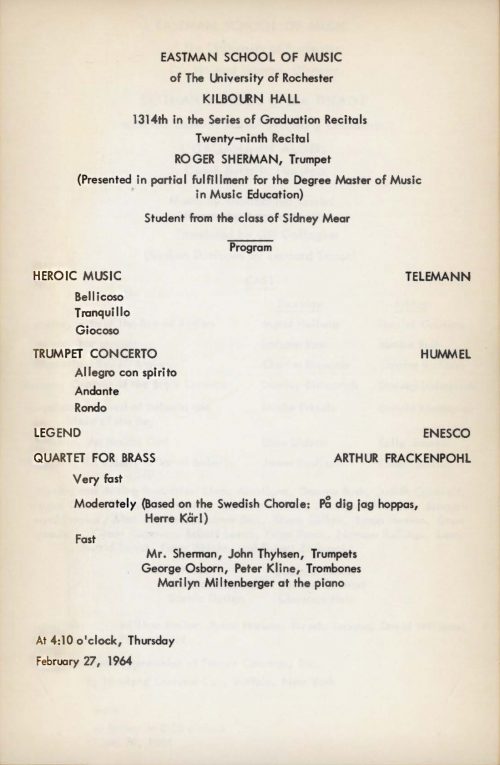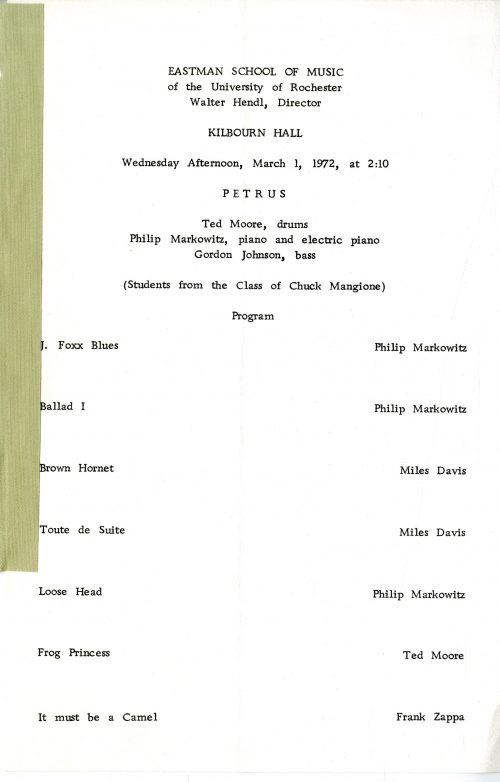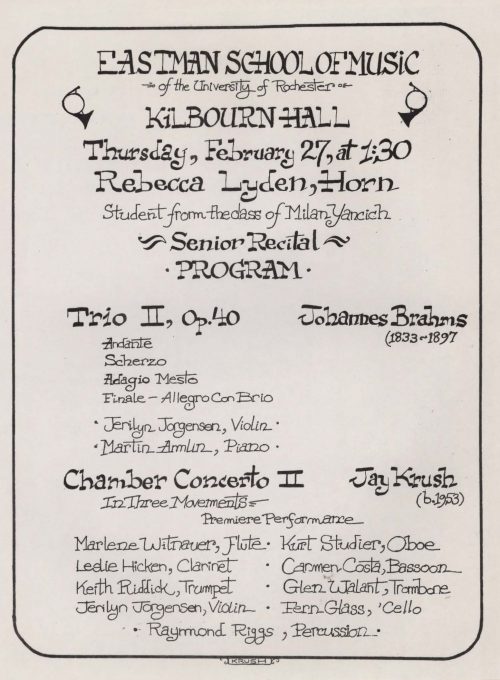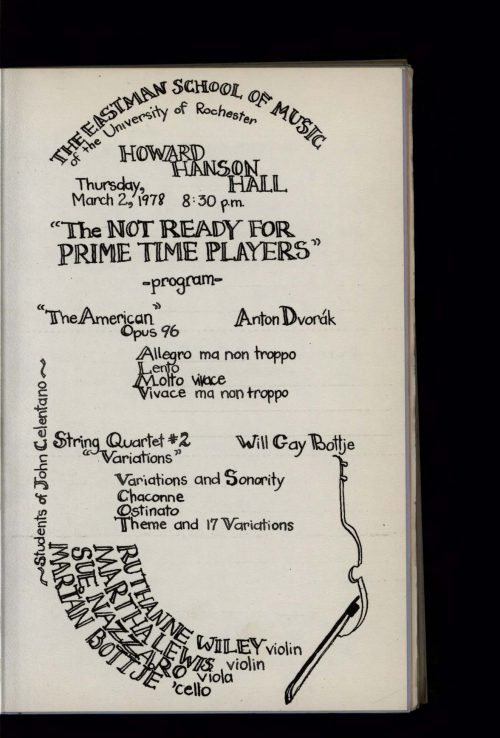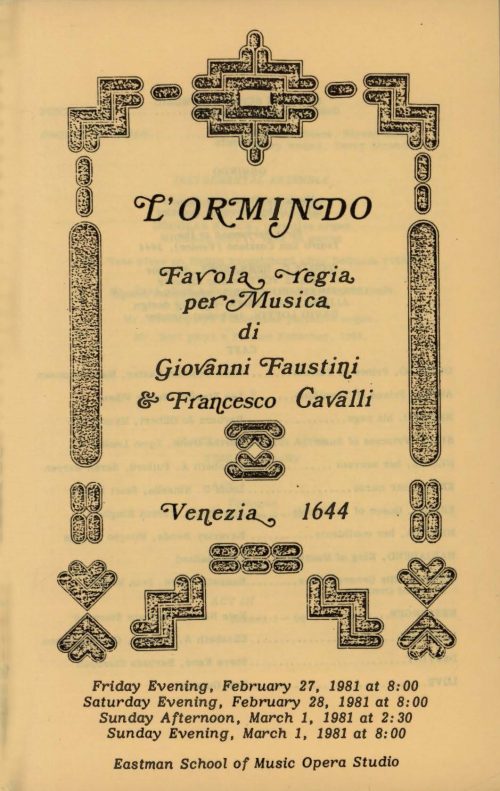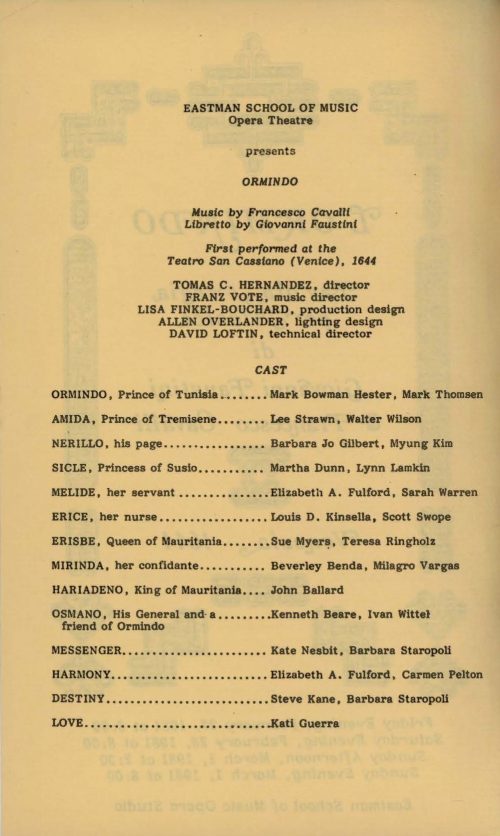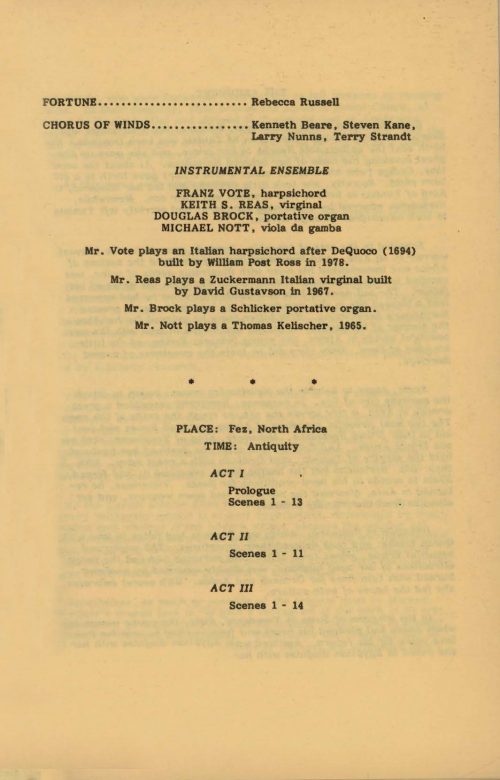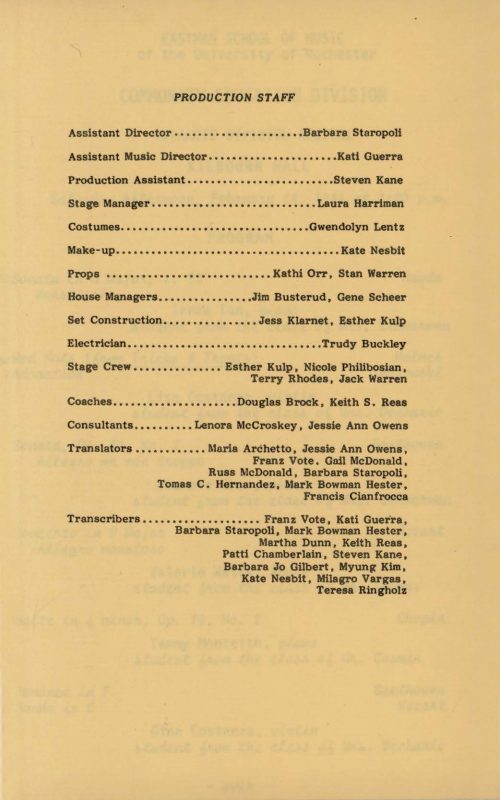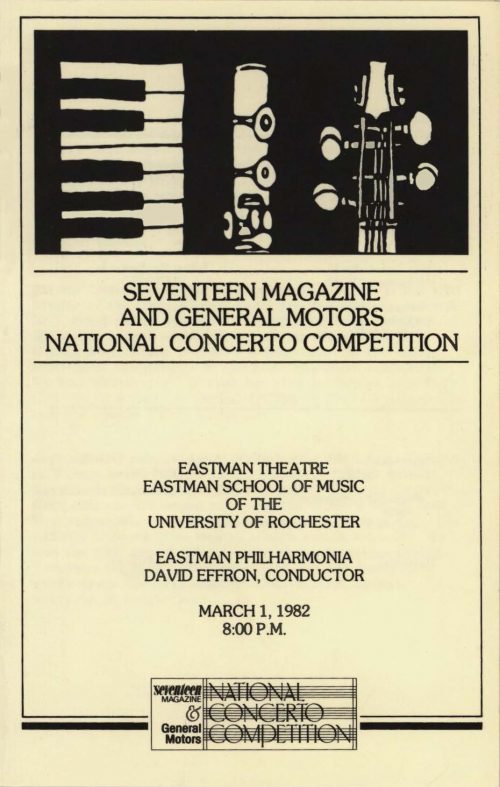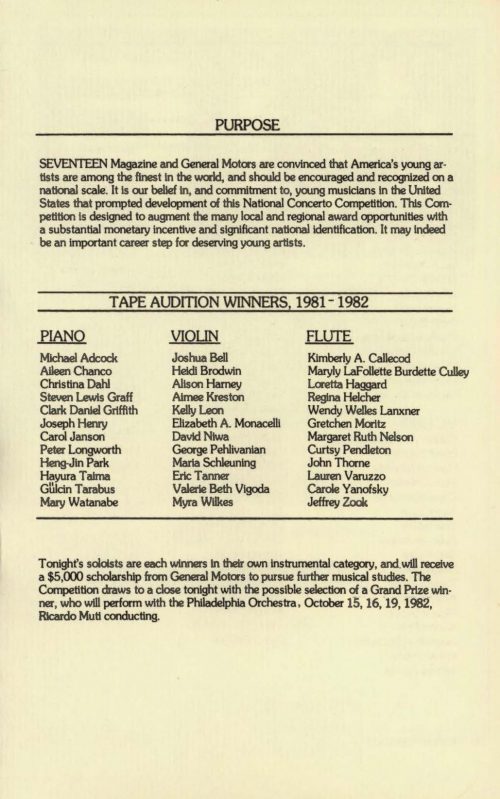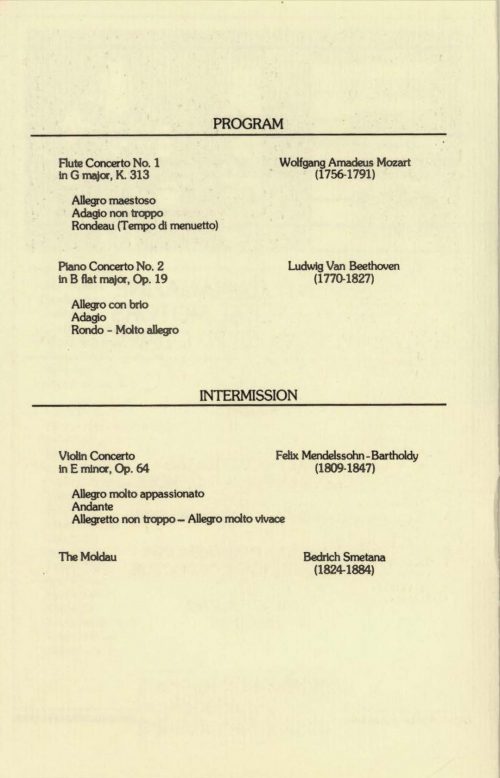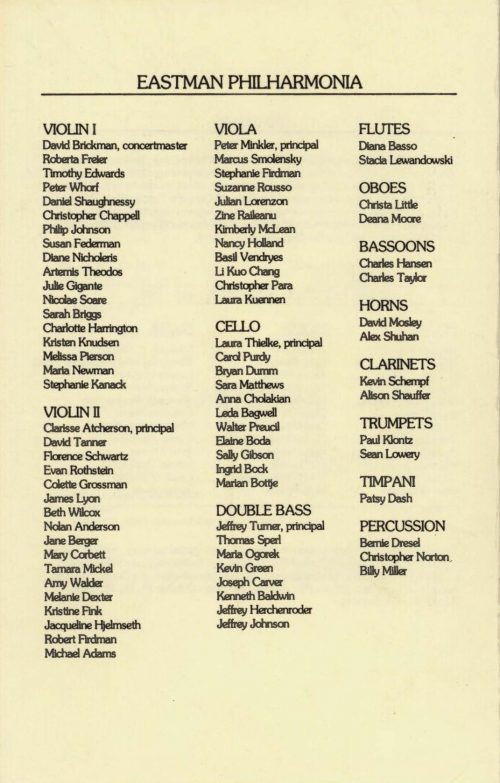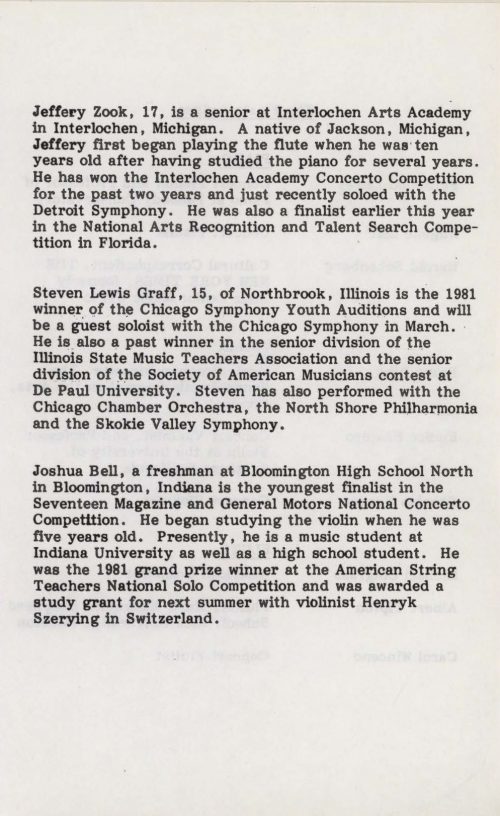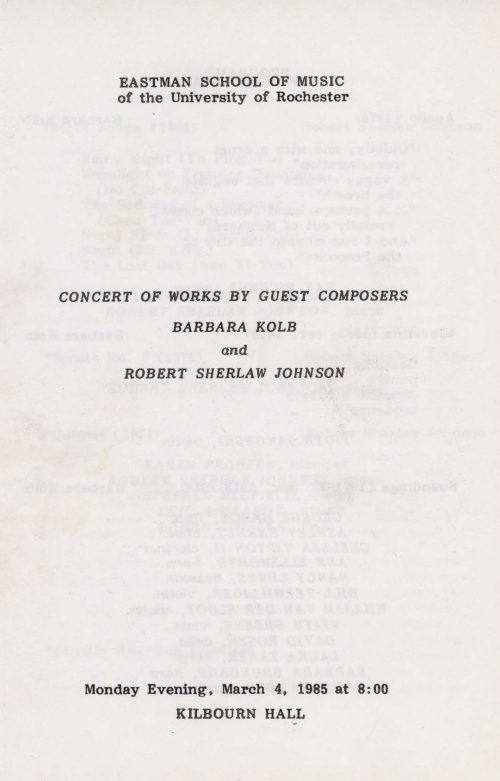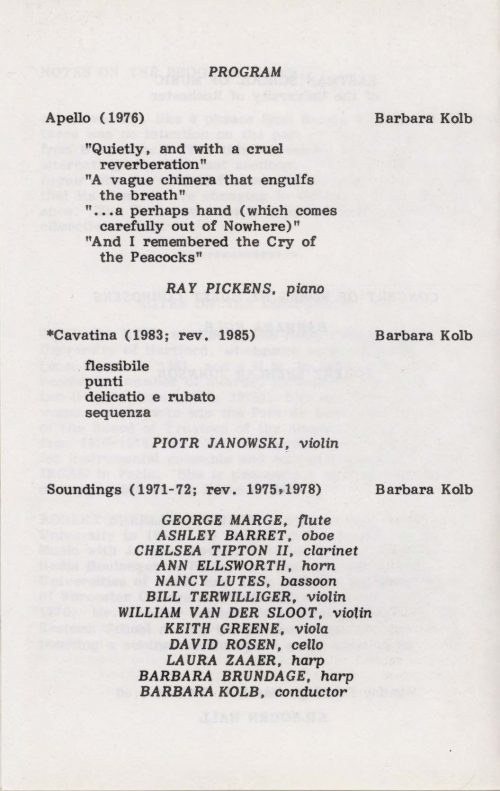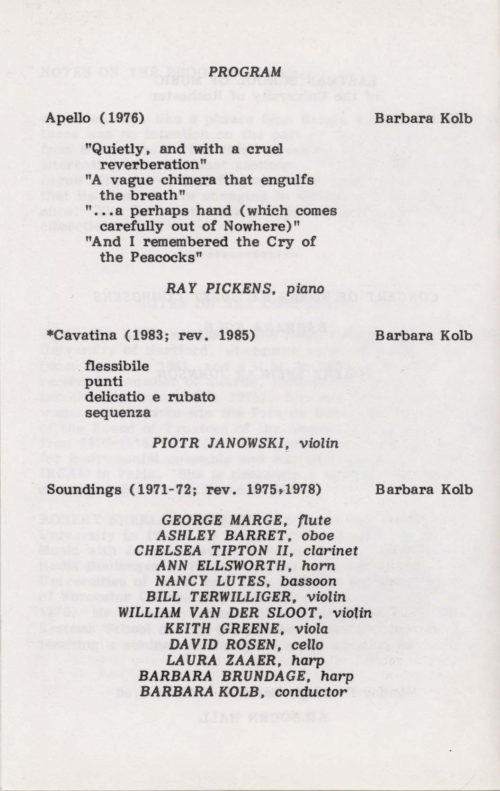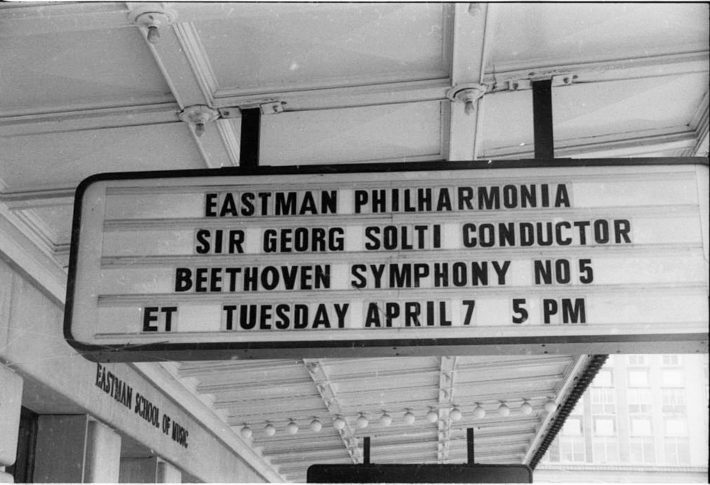Published on Feb 28th, 2022
1922: Formal opening of Kilbourn Hall
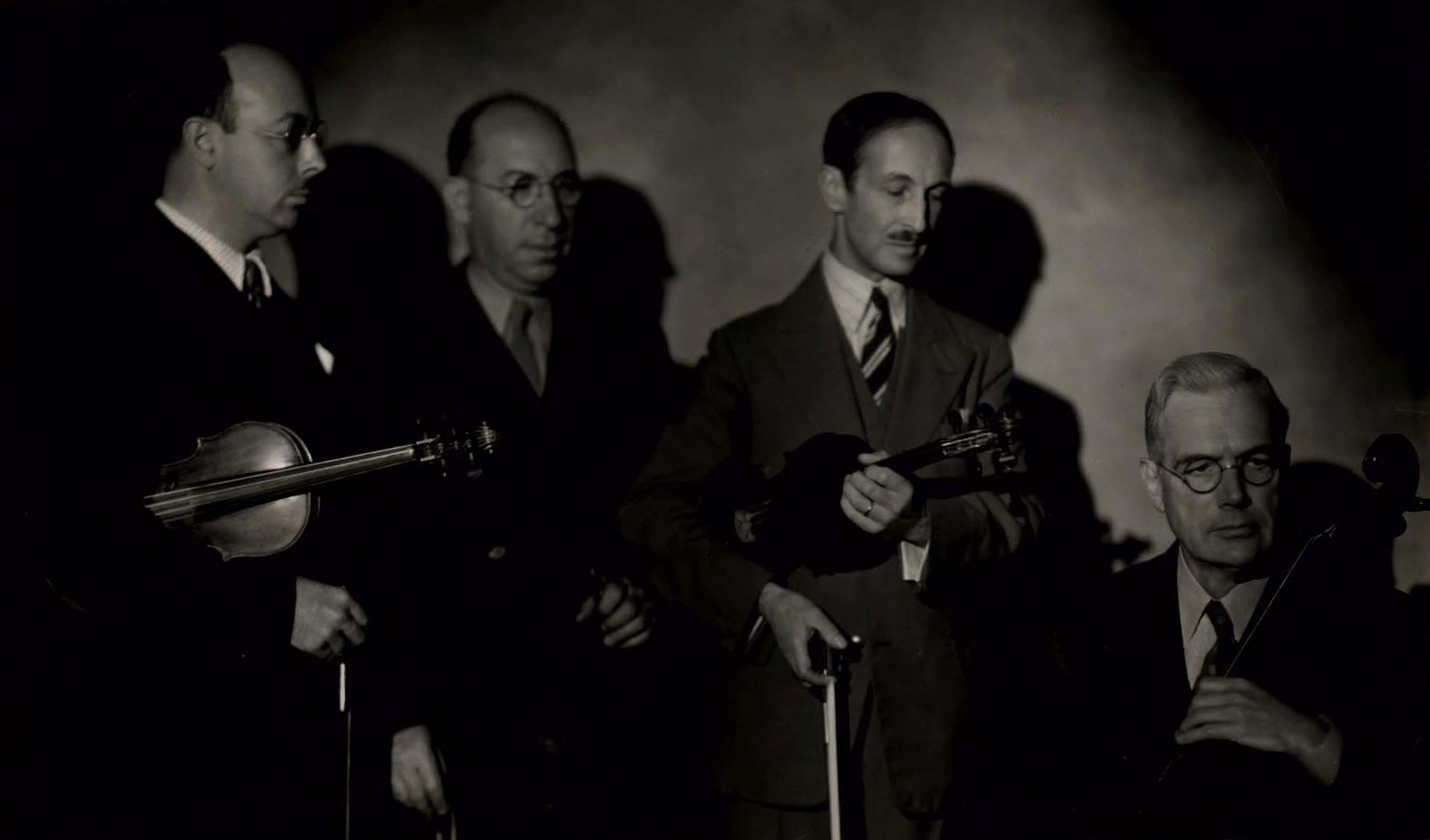
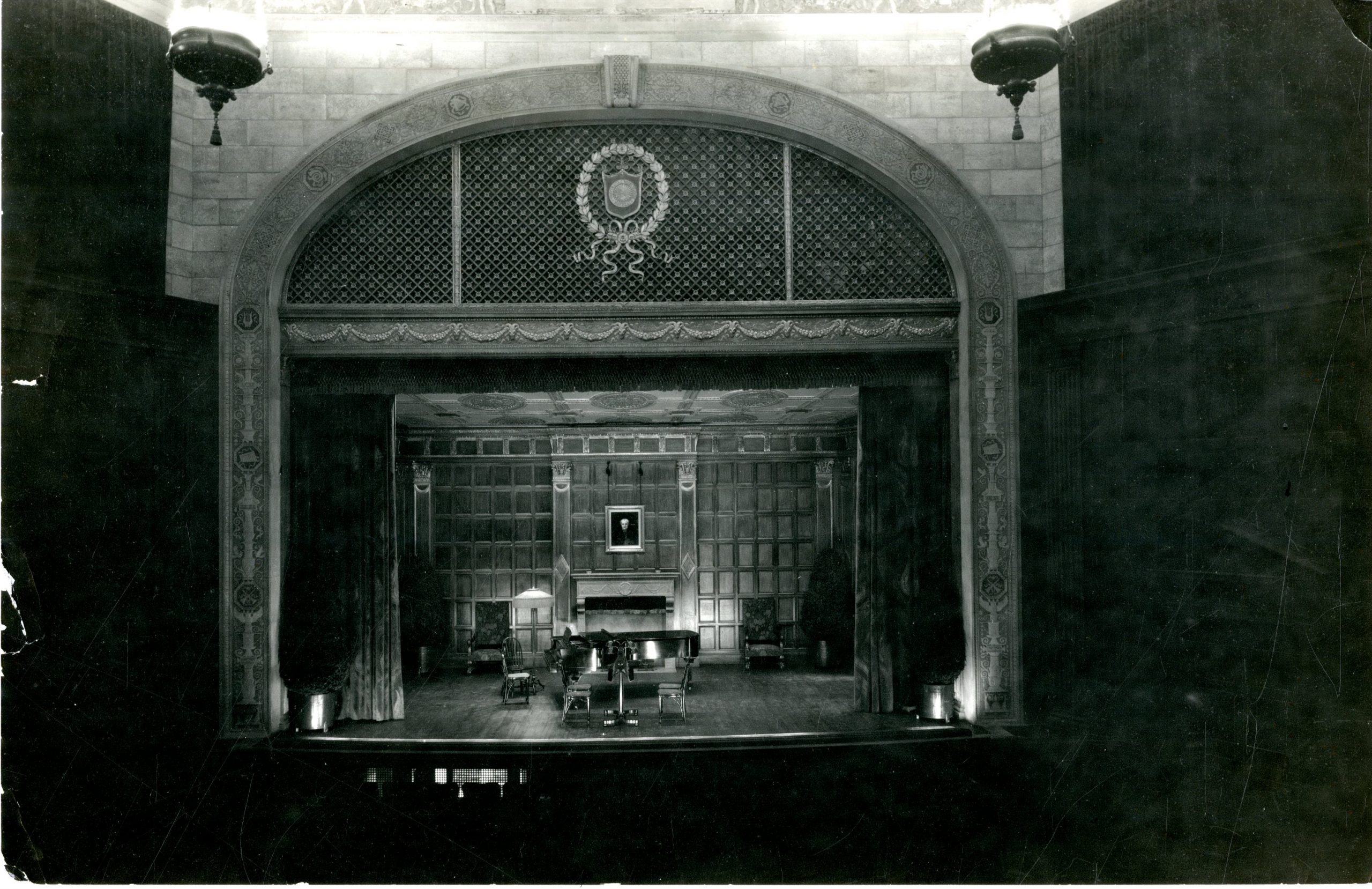
One hundred years ago this week, on March 3rd and 4th, 1922, Kilbourn Hall was formally opened to the public, marking the completion of the Eastman School portion of the building at 26 Gibbs Street. (The Eastman Theater would be completed later in the year and would be opened to the public on September 4th, 1922.) The opening of Kilbourn Hall, which was folded into a faculty chamber recital, signified not only the completion of the Eastman School facility, but also a formal dedication of the hall to the musical future of the city of Rochester.
The printed program for the hall’s formal opening indicates events on two dates: Friday, March 3rd, when the opening recital was performed for a private audience; and Saturday, March 4th, when the opening recital was repeated, this time for the public. On both evenings, guests were cordially invited to tour the entire building, a gesture that signified the Eastman School opening its doors to the public, much as we will do on March 2-6, 2022. Curiously, the performers’ names were not printed in the program, but press accounts of the event confirm that it was the Kilbourn Quartet—the Eastman School’s first resident string quartet—performing the Beethoven, and then they were joined by Eastman School Director Alf Klingenberg on piano for the Christian Sinding work. (The press also reported that Mr. Sinding, a member of the Eastman School faculty, was in the audience.) Attendance was high, with fully 1,500 invitations having been sent out for each evening’s event. The Rochester press later reported that some 2,000 guests had visited the Eastman School premises on the Saturday evening which had signified the general opening.
While not indicated in the printed program, the Rochester press reported that Dr. Rush Rhees, President of the University of Rochester, read a statement from the stage between the Beethoven and the Sinding works. Speaking on the meaning of the Eastman School and of Kilbourn Hall to the people of Rochester, Dr. Rhees proclaimed, “There is even a broader thought of education behind all this, besides training and developing musical talent, and that is to build up a community which will love and appreciate music.” Such were Dr. Rhees’ words one hundred years ago; as for the results of such an endeavor, the history of the past century will amply bear witness.
A special dedication edition of the Eastman School’s student newspaper, The Note Book, was released on Thursday, March 2nd, immediately preceding the formal opening. The Note Book was a newspaper published by and for the students of the Eastman School over a four-year period (1921-1925), conveying all manner of school news and “overheard-in-the-corridor” scuttlebutt. Previous issues of The Note Book had contained glowing accounts of the progress being made towards completion of the building. The special dedication edition presented a wealth of information about the Eastman School’s physical plant generally, and about Kilbourn Hall in particular, much of it sourced from the daily Rochester press. The special dedication edition may be perused in its entirety, together with all other issues of The Note Book, here
One aspect of the formal opening of Kilbourn Hall deserves special mention, that being a special verse that had been written for the occasion. Professor John Rothwell Slater was a faculty member in the University’s English Department (served 1905-1940), and also served the University in various capacities throughout his distinguished tenure, including those of University Bellman (i.e., carillonneur) and Acting Librarian (1939-1940). Among Professor Slater’s unique contributions are the verses that he wrote on numerous special occasions to celebrate some facet of the University of Rochester or, more broadly, the city of Rochester. For the occasion of the Kilbourn Hall opening, Professor Slater wrote a lyrical ode that was printed in the Kilbourn Hall opening program. The verses are presented here in their entirety.
KILBOURN HALL
Here shall music have a home.
Here shall many lovers come,
Seeking at her inner shrine
Meanings intimate, divine.
These four walls shall hear the strings
Telling of immortal things.
Youth and age and music meet
Here beside the busy street.
Youth’s allegro violin,
Love’s adagio stealing in,
Joy’s gay scherzo and caprice,
And the final chords of peace:
Life’s sonata, played for all
In this dedicated hall,
All who know and all who care
For the fine things and the rare.
In this consummated whole
Rochester shall find a soul.
Dreams of years take form at last;
Beauty rises from the past.
Mothers see more than children know:
Mother of music, long ago,
Could you dream these marble halls
Where the voice of beauty calls?
Could you hear the harmony
Still unuttered, still to be?
Are you waiting now to hear
Music of the future clear?
Happy mother, so to come
To your everlasting home.
—John R. Slater (1872-1965), Professor of English, University of Rochester
written for the opening of Kilbourn Hall on March 3rd and 4th, 1922
Printed program for the formal opening and dedication of Kilbourn Hall on March 3rd and 4th, 1922. The first evening was for an invited audience and the second evening was for the general public.
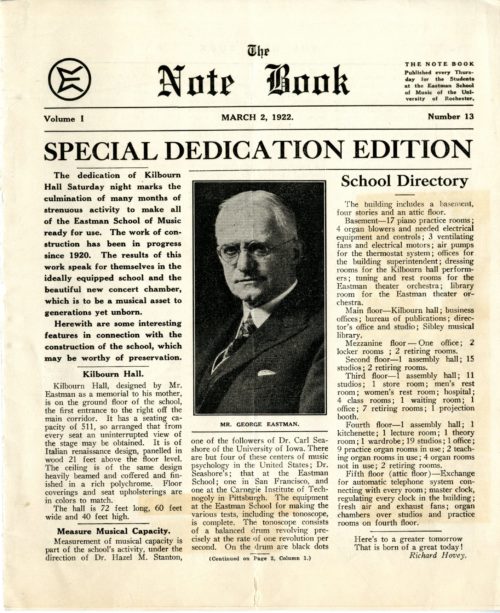
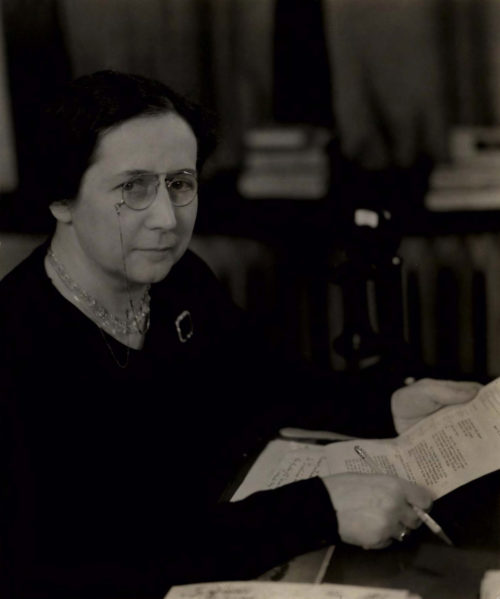
1960: Departure on tour of the Eastman String Quartet
Sixty-two years ago this week, on March 2nd, 1960, the members of the Eastman String Quartet departed on a nine-week tour that would take them to Eastern Europe, the Near East, and Northern Africa, constituting the first international tour by any Eastman School ensemble. Departing from Rochester on March 2nd, the four musicians spent one night in New York City before catching their trans-Atlantic flight to Europe. After a change of planes in London, the four men landed in Paris at mid-day on March 4th. They would spend four full days in the French capital before flying on March 8th to Belgrade, Yugoslavia, where they would begin their performing.
Altogether, between March 2nd and May 9th, the members of the Eastman String Quartet would perform 40 concerts in 25 cities in eight countries, logging a total of 30,000 miles. The countries on the itinerary were Yugoslavia, Greece, Turkey, Lebanon, Syria, Jordan, Egypt, and Morocco; a copy of the itinerary is displayed here. The tour was sponsored by the International Cultural Exchange Service of the American National Theatre and Academy, a body chartered by the United States Congress. In keeping with the tour’s mission of cultural exchange, the Quartet members played not only an artistic role, but also a diplomatic role. At many stops along their route, the Quartet members were hosted at functions and receptions attended by state and artistic dignitaries in those respective locales.
The Eastman String Quartet was the third of the Eastman School’s resident string quartets, following the Kilbourn Quartet and the Gordon String Quartet. Like many a chamber ensemble, its personnel composition was not static with the passing of time, but in 1960, the Quartet was comprised of first violinist Joseph Knitzer, second violinist John Celentano, violist Francis Bundra, and violoncellist Georges Miquelle. Profiling the four men in brief:
Francis Bundra (1928-2000), M.M. ’57, joined the Eastman String Quartet in 1959, succeeding Francis Tursi as the Quartet’s violist, and remained a member of the Quartet through the 1962-63 season. He later served on the faculty of the University of Michigan (1965-81).
John Celentano (1912-2009), BM & PC ’37, MM ’41, served on the Eastman School faculty for 33 years (1946-79), after which he was named Professor Emeritus. Mr. Celentano began his faculty service immediately after his wartime service in the U. S. Army Air Force; his was a career of distinguished service as teacher, performer, and widely travelled clinician and adjudicator. Director Howard Hanson formally tasked Mr. Celentano with founding the Eastman School’s program in chamber music. In 2000 the University of Rochester conferred on him the status of Distinguished Professor Emeritus of Chamber Music.
Joseph Knitzer (1913-1967) served on the Eastman School faculty for ten years (1954-64). He had studied under Leopold Auer and Louis Persinger and graduated from the Institute of Musical Art and the Juilliard Graduate School. Before his Eastman appointment he had taught at the Cleveland Institute of Music (1941-54) and had appeared as soloist with most of the major U.S. orchestras. His dozen or so New York City appearances had included recitals at Carnegie Hall and at Town Hall.
Georges Miquelle (1896-1977) served on the Eastman School faculty for ten years (1954-64). Born in Lille, France, he studied at the conservatory in Lille and then at the Paris Conservatoire where he won first prize in violin and graduated with highest honors. He taught at the Longy School of Music in Boston (1918-25) and then served as principal ‘cellist of the Detroit Symphony Orchestra (1925-54); he also maintained a private studio in Detroit during that time. His c.v. promoted that he had appeared in concert with composers Ravel, Bartok, Ernst Toch, Honegger, Roy Harris, d’Indy, and Florent Schmitt playing their own works.
In 2003 Mr. Celentano, the last surviving member of the Quartet, archived his papers at the Sibley Music Library, the only member of the Eastman String Quartet to have done so. His papers enable us to understand something of the preparations for the tour, together with the week-by-week details of travel and performing. Mr. Celentano wrote home at least every other day to his wife Mary, who faithfully preserved his postcards and letters which are now archived. Future entries of “This Week at Eastman” will trace the movement of the Eastman String Quartet on their tour.
Copy of the itinerary for the Eastman String Quartet tour in March-May, 1960. John Celentano Collection.
Copy of the contract that was administered to each member of the Eastman String Quartet for the March-May, 1960 tour. John Celentano Collection.
1968: “Khachaturian Week” at Eastman begins
Director Walter Hendl sharing a private moment of conversation with composer Aram Khachaturian and his wife, Nina Makarova. It was reported during the Eastman School’s “Khachaturian Week” that Mr. Hendl conversed in German with the composer. ► R339-16, R340-4A
Four shots from the Eastman Philharmonia rehearsal with guest conductor and composer Aram Khachaturian on March 4th, 1968. ► R340-5A, R340-6A, R340-10A, and R340-15A
Fifty-four years ago this week, March 4th, 1968 marked the beginning of “Khachaturian Week” at the Eastman School of Music. Armenian-born composer Aram Khachaturian (year-year) was just then on a conducting tour in the U.S., and the Eastman School took advantage of his presence in the country to host him for a week’s residency.[1] There had already been three other such weeks during the Walter Hendl administration (1964-1972) at the Eastman School, each one complete with the residency of the featured composer. Those previous composers’ weeks had recognized Howard Hanson (1966), Igor Stravinsky (1966), and Peter Mennin (1967). Each of the occasions had enabled Eastman School students to learn through direct interaction with the composer in question, whether conversing with the composer in the moderated context of a symposium or convocation, or whether receiving counsel from that composer in rehearsal. Such would again be the agenda during Khachaturian Week. Further, while the aims of “Khachaturian Week” were pedagogical and musical in nature, the invitation of Aram Khachaturian to a residency at the Eastman School at this particular time no doubt also reflected Director Hendl’s own professional activities associated with the USSR in the mid- to late-1960s. In 1965 he had conducted the Western Hemisphere premiere of the Requiem, opus 27 by Dmitri Kabalevsky; in 1966 he had served as a juror at the Third International Tchaikovsky Piano Competition (1966); and he had been booked for conducting engagements in the USSR later in 1968.
Arriving in Rochester on Monday, March 4th, composer Khachaturian came directly from the airport to the Eastman School, where he immediately went into a rehearsal with the Eastman Philharmonia, which he would be conducting in concert at week’s end. The following day, on Tuesday, March 5th, there was an all-school convocation in Kilbourn Hall at which composer Khachaturian was the guest of honor. The convocation served as the occasion for a Composers’ Symposium at which works by three student composers were performed; the composers were Joseph Packales, BM ’79; Max Stern, BM ’69; and Daria Semegen, BM ’68. The Symposium was moderated by Professor Wayne Barlow[2] and was followed by a discussion period during which composer Khachaturian fielded questions from members of the audience. The composer was assisted by his U.S. manager, Mr. Joseph H. Zarovich, who on this occasion served as translator. The Rochester press reported that the composer “appeared to be enjoying himself” during the exchange with the audience.[3]
The week’s events continued with a concert on the evening of Wednesday, March 6th. The composer was in attendance when the Eastman School Symphony Band gave a concert in the Eastman Theater. The program included the composer’s Armenian Dances in an arrangement by Ralph Satz, conducted by guest conductor Dr. Donald Shetler.[4]
“Khachaturian Week” would conclude in splendid fashion on the evening of Friday, March 8th when the Eastman Philharmonia would perform music of Khachaturian under the composer’s baton. Details to follow in next week’s “This Week at Eastman” entry.
Composer Khachaturian was accompanied to Rochester by his wife, Nina Vladimirovna Makarova (1908-1976), herself a composer of note in the former Soviet Union. Mme Makarova appears in numerous photographs taken during the week.
► Photos by Louis Ouzer
Four shots from the All-Convocation on March 5th, 1968 in Kilbourn Hall. Composer Khachaturian is seated together with Director Hendl, his wife, and his manager during the Composers’ Symposium; afterwards, on-stage in Kilbourn Hall are Director Hendl, Composer Khachaturian, Mr. Joseph Zarovich (the composer’s U.S. manager), and Dr. Wayne Barlow, moderator of the discussion portion of the event. R339-10, R342-4A, R342-12A, R342-16A
[1] “Sabre Dance Man” by George Kimball in The Rochester Times-Union, March 5, 1968.
[2] Dr. Wayne Brewster Barlow (1912-1996), BM ’34, MM ’35, PhD ’37, member of the Eastman School faculty in the Music Theory and Composition departments (1937-78) and at this time serving as Associate Dean of Graduate Research Sudies. For the record, Dr. Barlow’s Ph.D. had been the first doctoral degree in composition granted by the Eastman School of Music. The Sibley Music Library’s RTWSC holds a substantive collection of his manuscripts.
[3] “It’s ‘gifted’ jazz for Khachaturian” by George Kimball, Rochester Times-Union, March 6, 1968.
[4] Dr. Donald Shetler (1926-2014), member of the Eastman School faculty in the Music Education department (1965-88) and at this time Associate Chair of the Music Education faculty. He was an accomplished conductor in his own right. The Sibley Music Library’s RTWSC holds a substantive collection of his writings.
1972: Oliver Nelson premiere performance
Fifty years ago this week, on March 3rd, 1972, the Eastman Studio Orchestra appeared on-stage in the Eastman Theater in a concert marking two milestones: the world premiere performance of a newly commissioned work, and a collaboration with a renowned and sought-after jazz professional. The concert performance of Piece for Studio Orchestra and Soloist by Oliver Nelson featured the composer as guest soloist on alto saxophone, and it marked the latest in the Eastman School’s 1971-72 series of premiere performances of Fiftieth Anniversary Festival commissions. The Eastman Studio Orchestra and Mr. Nelson performed the new work again on the following evening when the Eastman Jazz Ensemble and Eastman Studio Orchestra gave a special performance for employees of the Eastman Kodak Company. The Oliver Nelson work was one of three new works that were introduced in the March 3rd program; the others were J. Foxx Blues, composed and arranged by J. Markowitz, BM ‘74; and It’s a Great Day, arranged by Jeff Tkayzik (now Tyzik), BM ’73, MM ’77.
► Printed program, March 3rd (9 pages)
► Printed program, special performance on March 4th (8 pages)
Oliver Nelson’s appearance at the March 3rd concert was actually just the beginning of a more extensive collaboration with the Eastman Studio Orchestra. Mr. Nelson would accompany the Eastman musicians several days later when the Eastman Jazz Ensemble and the Eastman Studio Orchestra, directed respectively by Chuck Mangione and Rayburn Wright, would depart on a three-city tour. Each of the three new works introduced at the March 3rd concert would be performed during the tour. There would be three concerts: the first at Walnut Hills High School in Cincinnati (March 8th); the second being a Jazz Night Concert at the Music Educators’ National Conference in Atlanta (March 10th); and the third under the auspices of the program “Jazz: Unlimited Horizons in Music Education” at Fisk University in Nashville (March 11th). In each of those concerts, Mr. Nelson not only appeared as soloist in his own work, but also joined the Eastman Studio Orchestra in playing solo soprano saxophone in Jeff Tkayzik’s arrangement of Neil Young’s Ohio.
While on-site at Eastman Mr. Nelson also gave a master class; some photos from that session are displayed here.
Oliver Nelson with Eastman School Jazz and Contemporary Media students in master class in Room 120 (today the Rayburn Wright Room)
► Photos by Louis Ouzer: R1442-12A, R1442-16A, R1442-19A, R1442-28A
Oliver Nelson, Chuck Mangione, and Ray Wright confer on the podium in the Eastman Theater preparatory to the Eastman Jazz Ensemble and Eastman Studio Orchestra joint concert of March 3rd, 1972.
R1445-25 and R1445-31
Click here for a brief excerpt from the March 3rd, 1972 performance of the Piece for Studio Orchestra and Soloist.
Audio PlayerMembers of the networked U of R community—that is, all end-users with current UR netID and log-in credentials—can hear the complete work (duration 13:28) via the Ampache interface here
Oliver Nelson (1932-1975) was highly versatile as a saxophonist, clarinetist, arranger, composer, and bandleader; by the age of 30 he had solidified his reputation as a composer and arranger. A native of St. Louis, Missouri, Mr. Nelson had had formative musical experiences during his military service in the U.S. Marine Corps, playing woodwinds in the 3rd Division Marine Band. It was during his USMC service that he decided to become a composer; returning home to Missouri, he earned degrees at Washington University and at Lincoln University, and studied with such eminent professionals as Elliott Carter. As with so many an accomplished professional, Mr. Nelson’s professional biography is studded with a myriad of different jobs and collaborations while on his upward path. After moving to New York City, one of his jobs was working as house arranger for the Apollo Theater in Harlem; he also worked briefly with Count Basie and with Duke Ellington.
After playing lead saxophone on six albums for the Prestige label between 1959 and 1961, he scored his breakthrough with his 1961 album The Blues and the Abstract Truth, released on the Impulse! label. The album was significant in several respects, and it firmly established Mr. Nelson as a composer-arranger. The album’s track “Stolen Moments” quickly became a standard in the jazz repertory; it has been performed and recorded by many mainline artists. One further indication of the track’s acceptance as a standard was that “Stolen Moments” made its way into The Real Book, the essential text for the developing jazz student. The Blues and the Abstract Truth also represented Mr. Nelson’s sole collaboration with renowned pianist Bill Evans (1929-1980). Bill Evans will be featured in a future “This Week at Eastman” entry; stay tuned.
Mr. Nelson later moved to Los Angeles and became involved with film and television. He composed scores for such series as Columbo, Night Gallery, and The Six Million Dollar Man, each of which has gone into syndication in the past half-century. His work in film included the highly popular Franco-Italian release Last Tango in Paris (1972), for which he arranged and conducted the score. Altogether, his work in film and television encompassed more than two dozen separate TV series and motion picture productions, and his discography numbered more than thirty recordings. Sadly, Oliver Nelson died all too young, succumbing to a heart attack in 1975 at the age of 43.
I thank my Sibley Music Library colleagues Jim Farrington, Robert Iannapollo, and Rick McRae—ardent jazz aficionados all—for sharing with me their insights into Oliver Nelson’s work and legacy, which enabled me to understand more deeply the significance of Mr. Nelson’s Eastman School commission and collaboration.
1982: Emanuel Ax master class
Forty years ago this week, on March 4th, 1982, concert pianist Emanuel Ax gave a master class in Howard Hanson Hall. This master class marked yet one more in a truly remarkable series of master classes during the Eastman School’s 60th anniversary year, 1981-82. Previous entries in “This Week at Eastman” have taken note of others in the series.
A highly sought-after artist, Mr. Ax (b. 1949) needs no introduction. Born in Lvov (today Lviv) of Polish-Jewish heritage, he resides in New York City and has been a faculty member of the Juilliard School since 1990. He was the winner of the first Arthur Rubinstein International Piano Competition in 1974, the Michaels Award of Young Concert Artists in 1975, and the Avery Fisher Prize in 1979. Among his numerous recognitions, he has received Grammy Awards in both the Best Chamber Music Performance category and the Best Instrumental Soloist Performance (without orchestra) category.
► Photos by Louis Ouzer.
Emanuel Ax working with an Eastman School piano major in Howard Hanson Hall. R3072-22, R3072-23, R3072-24, R3072-25
Pianist Emanuel Ax with Professor David Burge during Q&A in Howard Hanson Hall.R3072-29, R3072-30, R3072-31
The Weekly Dozen
In this week’s “Weekly Dozen” we recognize a performance from the era when dance was present in the Eastman School’s curriculum; one of Howard Hanson’s American Composers Concerts; a dramatic production by the school’s French Club; a symposium that brought students from seven institutions to Eastman to play chamber music; a production of a genuine rarity in the operatic repertory; a performance by an enterprising student jazz ensemble; and some superlative student performances such as grace the Eastman concert calendar each week of the semester.
►March 3, 1932 : American Composers’ Concert
►March 3, 1934 : Seventh Annual French Club Play
►March 4-7, 1948: Second Annual American Music Students’ Symposium
►February 27th/March 1, 1981 : Eastman Opera Theater production of L’Ormindo
►March 1, 1982: Seventeen Magazine and General Motors National Concerto Competition
►March 4, 1985 : Concert of works by guest composers Barbara Kolb and Robert Sherlaw Johnson
